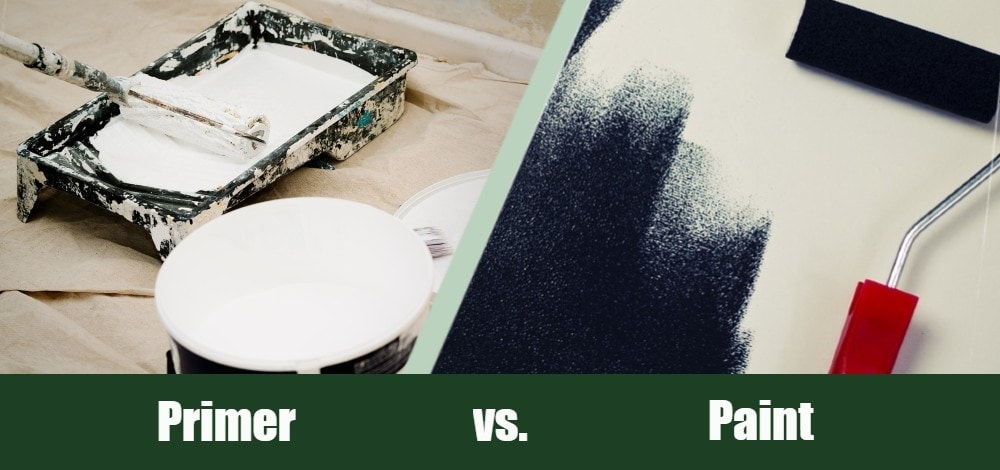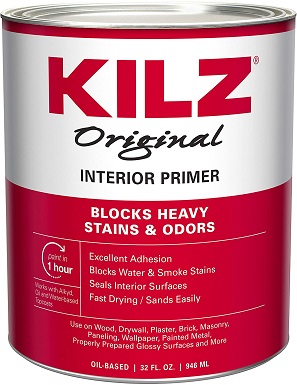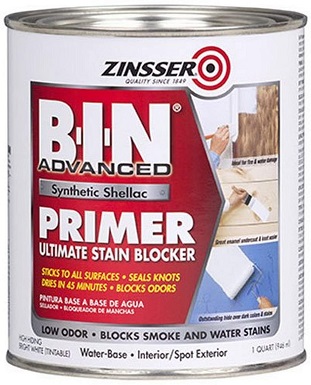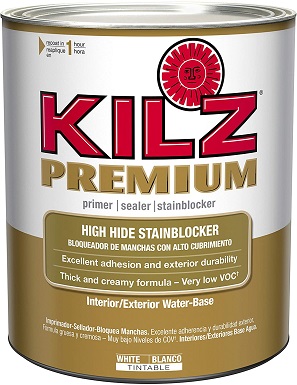Primer vs. Paint: What’s the Difference?
-
Pete Ortiz
- Last updated:

“When do you need to use a primer?” is one of the most common questions we hear. The second most common question is “what is the difference between the two?”. If you are not a professional painter, the need for a primer under your color choice may not seem that important. In reality, it can make the difference between an opaque and long-lasting color, and between a cracking and stained mess.
To help ease some of the confusion, we have broken down the differences between these two mediums. We will show you how they differ, when to use a primer, what the benefits are, and everything else we could think of to help.
We will also cover which materials are better suited to which primer, and how they should be applied to get the smoothest finish. You may be surprised by a few misconceptions that we have straightened out below! Keep reading to learn more.
The Essential Differences and Functions
The essential difference between paint and primer is the actual makeup of the product. Primer contains more resin than paint and has little to no pigment. The higher consistency of resin helps it create a smooth, paint-grabbing surface for the color. Basically, primer is paint without color pigments.
Paint, on the other hand, has more pigment than resin to give an opaque covering of color. It also has additives that the primer does not, such as fast-drying agents, gloss medium, and durability agents. Paint is also used to protect the surface of the substrate and hide unsightly stains. You also have the option of different finishes from high shine to matte appearances.
Varying substrates have different textures and properties. A coat of primer will smooth and seal the surface, hide stains, and create a uniform color for painting. They also provide a paint-grabbing surface that allows the pigment to stick. Wood is a great example of a material that requires a layer of primer.
Wood is naturally porous and can be textured even after sanding. Depending on the type, this substrate also tends to be monochromatic in appearance. Without a solid layer underneath, the paint would seep into the wood, have an uneven pigment distribution, and not appear to be smooth.
This is why primers are so important to the outcome of your paint job. One coat will seal the wood plus create a smooth surface for the paint to be applied. Without the barrier of the primer, the pores will create microscopic air pockets between the wood and paint. This will allow the paint to peel and crack within a short time frame.
Another important aspect of priming is it reduces the number of coats of paint you will need. Without this sealing layer, you will use far more paint, which is more expensive than primer. Many people also mistakenly think that primers are clear because they lack pigment. This is not true, though. It is white and does not come in a variety of colors. You can have your primer tinted to match your paint color, however. If your color is deep, or if you are changing from a dark to light tone, tinting the primer will help the opaqueness of the color transition to the substrate more effectively.
Materials
Each material requires a protective layer for different reasons. The primer you choose can also depend on the situation and whether the material has had any previous painting—which we cover further below. First, though, here are the most common materials that require a coat of primer before painting:
- Wood: Even though we have gone over the importance of priming wood above, there are a few other things to consider. Wood is not only porous and textured, but it can have knots, discoloration and naturally produce different chemicals, such as tannic acid. Tannic acid can break down the pigment in paint when there is no barrier to prevent it from seeping through.
- Metal: As metal is not painted as often as other materials, many people do not realize the importance of priming it first. Most metals will rust over time from exposure to the elements. Primer is another layer between the metal and corroding moisture.
- Man-Made Materials: Box furniture stores such as IKEA have made synthetic wood popular. More often than not, these materials are very smooth causing the paint not to stick and chip off.
- Drywall: New construction drywall can be just as porous and discolored as wood. Priming drywall prevents chipping and peeling, and what’s more, it allows for a high-shine finish. Adding a protective layer will also be more cost-efficient because drywall is so absorbent. Plus, you will save your body the physical strain of applying several coats of paint.
- Brick and Stone: Painting brick and stone has become popular in the last several years. Typically, people want to preserve the texture of the stone, but do not want it to chip or peel. Luckily, there are different primers for different substrates, which brings us to our next topic.
Types of Primers and When to Use Them
In some circumstances, it is not about the material but the overall situation that determines the use and type of primer you will need. Oil paint, latex, deep color pigments, and various types of stains are just a few of the situations in which a particular type of primer will be needed.
The three most common types are oil, latex, and shellac-based primers.
Oil Primer
As a general rule, if you are going to paint over oil with latex you should use an oil primer first to keep the oil from seeping through the layer of color. Latex paint and primer is water-based, therefore, the oils will be able to push through the color. Picture a piece of greasy pizza left on a paper towel. The grease from the pizza will ooze through leaving an orange-ish oily mess.
If you use latex over oil paint without an oil primer, this exact scenario can appear on your walls. That being said, oil primers do not have the same concentration of oil as paint does, so it will not seep through. The only exception to this rule is if you are painting with oil over galvanized metals. Oil does not adhere to metal so without a latex primer the paint will flake off.
Oil primers can be used for interior or exterior jobs, and it creates a smoother finish than other types would. It is slow drying, yet it retains its elasticity during temperature fluctuations, which makes it durable. Oil-based bottom coats are also great at hiding stains and are best used on wood or metal. It is not recommended for stone, however, and should not be used in damp weather.
Oil primer is also recommended in high-traffic areas, such as decks or walkways, as it is more durable and can stand up to frequent abuse.
Shellac-based Primer
High build or shellac-based primers are good for rough or very pores materials that need a little extra help smoothing out. These thicker options can cover considerable smoke damage, water stains, and other unsightly issues. It can be used for exterior spot treatments and interior work. High build layers are not as versatile as latex or oil primer in its uses, although you can use it on wood, plastic, drywall, stone, and many other materials
There is also an option called KILZ, which is a primer and stain remover in one. KILZ is typically only used when there is considerable water damage or other stains, however.
Latex Primer
Latex primer can be used on exterior and interior painting jobs and is good for almost all surfaces. It is made of less harsh compounds than oil or shellac, so fumes are not as toxic. Latex also does not have to be thinned and can be used under most types of paint and with all finishes. Tinting this kind of primer is also easier than any other type.
One aspect of latex primer that you should be careful of is it can raise the grain on wood or drywall. What happens is the tiny grains in the substrate will react to the resin and lift off of the surface. This can be a good or bad thing depending on the project. If you plan to sand the primer before painting, it will create a very smooth flat surface. On the other hand, If you are doing small areas where the primer will not be sanded, it can cause the appearance of the paint to be uneven or textured.
Other Considerations
As mentioned, latex and oil primer can both be sanded down to create a smoother finish. In fact, sanding can make a significant difference to the end result. Adding this extra step before painting is the best way to ensure your finished surface looks professional; especially if you will be spraying your pigment.
You will not always be doing an entire space, however. Spot priming can be done as well to cover stains or cover bare substrate. You also have the option of paint and primer in one. This can be difficult, though. Due to the many variables of the painting project, finding a “do it all” solution can be difficult.
Both paint and primers can be applied by a paintbrush, roller, or paint sprayer. To get the smoothest and most professional outcome, a sprayer is recommended. Spraying paint can be difficult for beginners, though, so take your time and practice before spraying your main project.
Also, keep in mind that thinning the paint/primer is important for oil spraying (sometimes latex, as well). It will need to be diluted with a thinning agent to get a consistent and opaque covering of color. Not to mention thinning is required to keep your spray gun working correctly. Oil paint, in general, will need to be thinned regardless of the application process.
The final consideration is regarding clean-up. Latex is fairly easy to clean up and remove from skin or other surfaces. Oil, on the other hand, is difficult to get off the skin and other surfaces without extreme measures. Gloves are recommended for both, but oil is especially important to maintain your spot at the dinner table.

Conclusion
Paint and primers have very different functions, though both are meant to protect the surface of the substrate and improve the appearance of the material. Primer seals your surface for a smooth application of color, and it protects the lifespan of the paint job.
Paint is your pigment that can be applied as a matte, sheen, or high-shine finish in any color. Paint is also there to protect the surface of the material from the elements and stains. Primer is what grabs the paint and keeps the cost low by preventing numerous coats.
We hope you have enjoyed this article, and it has helped shed some light on the question of primers versus paint!
- See also: What is the Colorhouse Paint Company?
Contents








